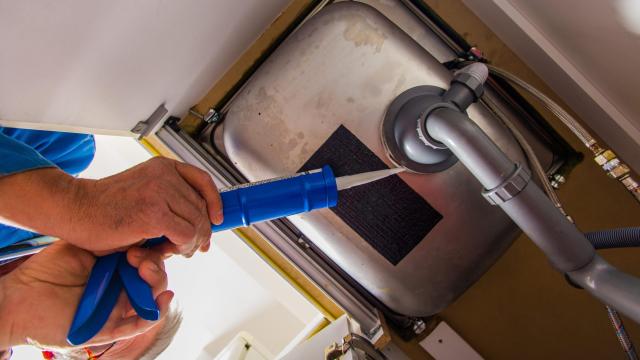Home repair or improvement projects rarely involve tackling a single problem, and then being done. Instead, one often leads to another — either because in the process of fixing or installing something, you discover additional things that need to be addressed, or because the process required to make the original repair ended up creating the need for others.
One example of the latter is under-the-sink plumbing. As Chris Deziel writes in an article for Hunker, when working in spots like this that tend to be out of sight, plumbers often create large, rough-cut holes for pipes, but don’t necessarily take the time to fill in the remaining gaps once the job is done.
And while that may sound harmless (after all, who’s going to see it?), those holes could cause problems for you down the line, like giving mice, bugs, and cold air an easy way into your kitchen. Here’s how Deziel — a building contractor and fix-it pro — suggests dealing with these gaps.
Use spray foam
If you’re new to spray foam, Deziel says that it’s “essentially liquefied polyurethane” that expands into a hardening foam, and has the ability to completely fill gaps up to two inches wide (though sometimes more). It’s also an insulator, and does a good job at keeping pests out.
Using spray foam is relatively straightforward, Deziel explains, but because of its tendency to stick to everything it touches, it can also be kind of tricky — especially since it’s incredibly difficult (if not impossible) to remove. Solvents are no match for it, and if you get it on your skin, “mechanical removal is required,” according to Deziel.
Spray foam usually comes in a 450 g aerosol can with a removable application tube. Here’s Deziel to explain how to use it:
Fit the tube onto the nozzle, place the end of the tube in the gap and squeeze the trigger. Fill gaps about halfway, and the foam will expand to complete the job. Keep a rag handy and cover the end of the tube as soon as you’re done spraying to avoid dripping any liquid onto the bottom of the cabinet.
Other ways to fill under-the-sink holes
Although the spray foam method is easy, it’s arguably also the ugliest. If you’re OK with that (again, this is under-the-sink we’re talking about), then by all means, go for it. But if you’re about to put your home on the market, for example, and want something moderately more attractive, Deziel has a few other suggestions.
The first is to use caulk to fill gaps less than about 1/2 inch wide. If you have holes wider than that, first stuff them with steel wool, and then caulk over it, he says.
Another option (and the most attractive of the bunch) involves patching compound, which Deziel describes as “a powder that sets rock hard when you mix it with water.” Use a trowel to spread and level-off the compound, then let it set for an hour. After that, apply a coat of drywall joint compound (which Deziel says is easier to sand flat). Finally, slap on a coat of paint, leaving the holes both out of sight, and out of mind.

Leave a Reply
You must be logged in to post a comment.